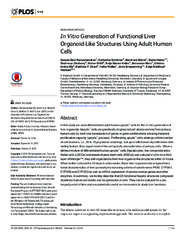In vitro generation of functional liver organoid-like structures using adult human cells
Permanent link
https://hdl.handle.net/10037/8633Date
2015-10-21Type
Journal articleTidsskriftartikkel
Peer reviewed
Author
Ramachandran, Sarada Devi; Schirmer, Katharina; Münst, Bernhard; Heinz, Stefan; Ghafoory, Shahrouz; Wölfl, Stefan; Simon-Keller, Katja; Marx, Alexander; Øie, Cristina Ionica; Ebert, Matthias P.; Walles, Heike; Braspenning, Joris; Breitkopf-Heinlein, KatjaAbstract
In this study we used differentiated adult human upcyte1
cells for the in vitro generation of
liver organoids. Upcyte1
cells are genetically engineered cell strains derived from primary
human cells by lenti-viral transduction of genes or gene combinations inducing transient
proliferation capacity (upcyte1
process). Proliferating upcyte1
cells undergo a finite number
of cell divisions, i.e., 20 to 40 population doublings, but upon withdrawal of proliferation stimulating
factors, they regain most of the cell specific characteristics of primary cells. When a
defined mixture of differentiated human upcyte1
cells (hepatocytes, liver sinusoidal endothelial
cells (LSECs) and mesenchymal stem cells (MSCs)) was cultured in vitro on a thick
layer of Matrigel™, they self-organized to form liver organoid-like structures within 24 hours.
When further cultured for 10 days in a bioreactor, these liver organoids show typical functional
characteristics of liver parenchyma including activity of cytochromes P450, CYP3A4,
CYP2B6 and CYP2C9 as well as mRNA expression of several marker genes and other
enzymes. In summary, we hereby describe that 3D functional hepatic structures composed
of primary human cell strains can be generated in vitro. They can be cultured for a prolonged
period of time and are potentially useful ex vivo models to study liver functions.


 English
English norsk
norsk